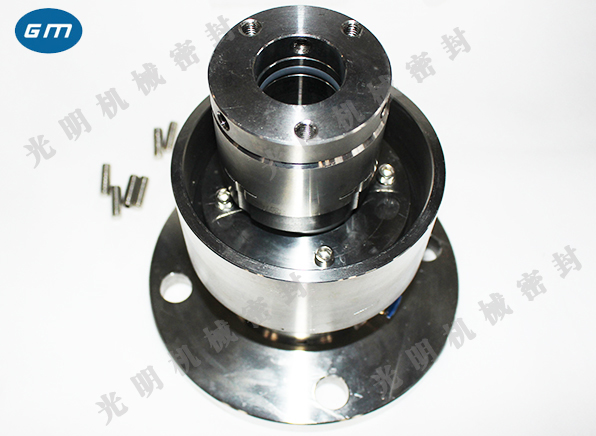
In the pump unit, the mechanical seal of motor equipment accounts for 80% - 85% of the total number of dynamic seals. Among the pump failures, mechanical seal failures account for about half of the total maintenance workload. It can be seen that the position of mechanical seal in pump maintenance. Because the medium conveyed by the pump is different and the process conditions are different, it is important to know these conditions for the selection and maintenance of mechanical seal. Combined with years of experience in the selection and maintenance of mechanical seals, the working characteristics and precautions of mechanical seals under several special working conditions are introduced.
1、 Mechanical seal at high temperature
Generally, if the temperature of the medium exceeds 120 ℃, it is considered as high temperature sealing. At this time, the main problems of the mechanical seal are: (1) As the temperature of the end face of the friction pair rises, the liquid film between the seal faces vaporizes, the friction coefficient increases, the wear intensifies, the temperature rise increases, and the seal ring fails due to thermal deformation or thermal cracking; (2) The material of auxiliary seal ring in mechanical seal is generally rubber or polytetrafluoroethylene, which is prone to aging and decomposition in high temperature environment for a long time, resulting in seal failure; (3) The elastic element of mechanical seal is prone to fatigue and creep under high temperature, which makes the seal invalid; (4) High temperature will intensify the corrosion of metal materials and shorten the service life of mechanical seals.
The following measures can be taken to ensure the normal operation of mechanical seal under high temperature environment.
1. Add cooling and flushing device to the mechanical seal.
2. Select high temperature resistant materials, and select different materials according to different working temperatures. The upper temperature limit of nitrile rubber is 80 ℃, that of silicone rubber and fluororubber is 200 ℃, and that of polytetrafluoroethylene is 250 ℃. In addition, non-metallic friction pairs in mechanical seals are mostly made of graphite impregnated materials, so different kinds of impregnated graphite should be selected according to different working temperatures. Generally, the applicable temperature range of impregnated babbitt alloy graphite is less than 150 ℃, and the applicable temperature range of impregnated resin graphite is 170~200 ℃. The graphite impregnated with copper, aluminum, and lead can be used under the working conditions of less than 400 ℃. Moving ring components shall be made of materials with similar expansion coefficient as far as possible to prevent loose connection between moving ring and moving ring seat under high temperature.
3. Select metal bellows mechanical seal. Metal bellows seal has been widely used in high temperature sealing in recent years, and has achieved good results. In this kind of mechanical seal, the metal bellows replaces the spring in the ordinary mechanical seal, and eliminates the auxiliary sealing ring of the moving ring. It does not need to overcome the friction and wear with the rotating shaft when the moving ring compensates, so it can generally achieve good results when used at high temperatures.
2、 Mechanical seal at low temperature
In oil refining and chemical plants, the medium transported at low temperature is generally characterized by small openness, poor lubricity and easy gasification. In addition, the medium absorbs a lot of heat during gasification, causing a sharp drop in ambient temperature, causing condensation of water vapor in the air, resulting in icing on the end face and its surroundings, resulting in loose fitting of the end face and leakage. At the same time, due to poor lubricity, more heat is generated by end face friction. If it cannot be transferred in time, it will inevitably aggravate the gasification at the end face, resulting in a vicious cycle and accelerating the early failure of the sealing surface. In addition, the auxiliary sealing ring of low-temperature sealing is hard and loses its elasticity at low temperature, which is also easy to lead to leakage.
For low temperature seal, in addition to selecting appropriate auxiliary seal ring material, the following points should also be noted.
1. Improve sealing structure and correctly select friction pair materials. It has been proved by practice that the hydrodynamic seal can be formed by opening an arc groove on the surface of the stationary ring, which can increase the bearing capacity of the fluid film, improve the lubrication condition of the end face, and effectively extend the working life of the mechanical seal. In terms of end face matching, tungsten carbide - M106K graphite pair (i.e. moving and stationary ring materials) is generally superior to other materials because of its good lubricity, low friction coefficient and good thermal conductivity.
2. Select appropriate end face pressure. Low temperature seals are prone to gasification and icing due to poor lubrication of the end face, so the end face specific pressure can be appropriately reduced on the premise of ensuring reliable sealing. The specific pressure of general mechanical seal is recommended to be 0.29-0.59MPa, and its lower limit can be taken for low temperature seal. For metal bellows mechanical seals, since the moving ring has no axial friction, the end face specific pressure can even be lower than the lower limit.
3. Take corresponding measures in process. For example, try to reduce the water content of the medium; Keep the seal chamber pressure relatively stable; Flushing and cooling devices shall be equipped as far as possible; Before starting the equipment, preheat the mechanical seal parts properly.
3、 Mechanical seal at high speed
When the speed exceeds 3000 r/min or the linear speed of the friction pair exceeds 25 m/s, it can generally be regarded as a high-speed seal. Under the condition of high speed, because the linear speed of the friction end face is very large, the heat generated by friction is also more. At this time, the liquid film on the end face is not easy to form, and the wear is intensified. High speed also easily causes vibration of the rotating ring, and is subject to greater centrifugal force, which is not conducive to the formation and maintenance of the liquid film between the end faces. Therefore, in the case of high speed, in order to reduce the impact of centrifugal force and vibration, rotating parts should be minimized and the spring static structure should be adopted. It can also strengthen the cooling and lubrication of the friction pair end face. In addition, friction pair materials with high [PV] value can be selected to reduce the contact width of the end face, or controlled membrane mechanical seal can be used. In recent years, a kind of mechanical seal called differential ring has also been applied in high-speed equipment. Because a differential ring is added between the original moving and stationary ring, the linear speed of the friction pair can be reduced by half, and good results have been achieved.
4、 Mechanical seal under high pressure
When the working pressure of mechanical seal exceeds 4-5MPa, it belongs to the scope of high-pressure seal. Under the high pressure condition, the excessive specific pressure of the seal face will cause the end face to heat, thus damaging the formation of the liquid film and causing abnormal wear. High pressure may also cause deformation and fracture of friction pairs. High pressure seals generally adopt balanced structure to keep the face specific pressure in an appropriate range. However, considering the reliability of the seal, the balance coefficient cannot be increased without limitation. Therefore, although the balance structure has been adopted in some cases, the face specific pressure may still be large. (Official account: pump steward) It is difficult to meet the use requirements by using the balanced structure alone. In this case, multi end mechanical seal or controlled membrane mechanical seal can be used.
5、 Mechanical seal in corrosive environment
Some mechanical seals are in a corrosive environment. At this time, it is not only necessary to pay attention to the corrosion resistance of each part of the mechanical seal itself, but also to prevent the electric coupling phenomenon that may occur when they are combined. For mechanical seals in corrosive environment, attention should be paid to the use of corrosion resistant materials. In addition, external mechanical seal can be used. For those with strong corrosivity that are prone to cause safety accidents, double end seals can be used and isolation liquid can be introduced for protection.
6、 Mechanical seal under granular medium
Some mechanical seals may work in the medium containing solid particles. When solid particles enter the friction end face, it is easy to cause severe wear, resulting in rapid failure of the seal end face. In addition, solid particles may make the moving ring seal ring unable to move along the axial direction, thus making the moving ring unable to float and lose its compensation, leading to mechanical seal failure. The effective way is to add an external flushing device. Since the pressure of the flushing fluid introduced into the sealing chamber is higher than the pressure of the sealing chamber medium, it can effectively prevent the particulate medium from entering the sealing chamber. In addition, double end mechanical seal can be used to add sealing fluid in the middle of the sealing chamber. External mechanical seal can also be used.
At present, mechanical seal has become the most common form of seal in the mobile equipment of oil refining and chemical plants, and its application scope will be further expanded with the continuous improvement of its design and manufacturing level and the continuous development of new materials.











